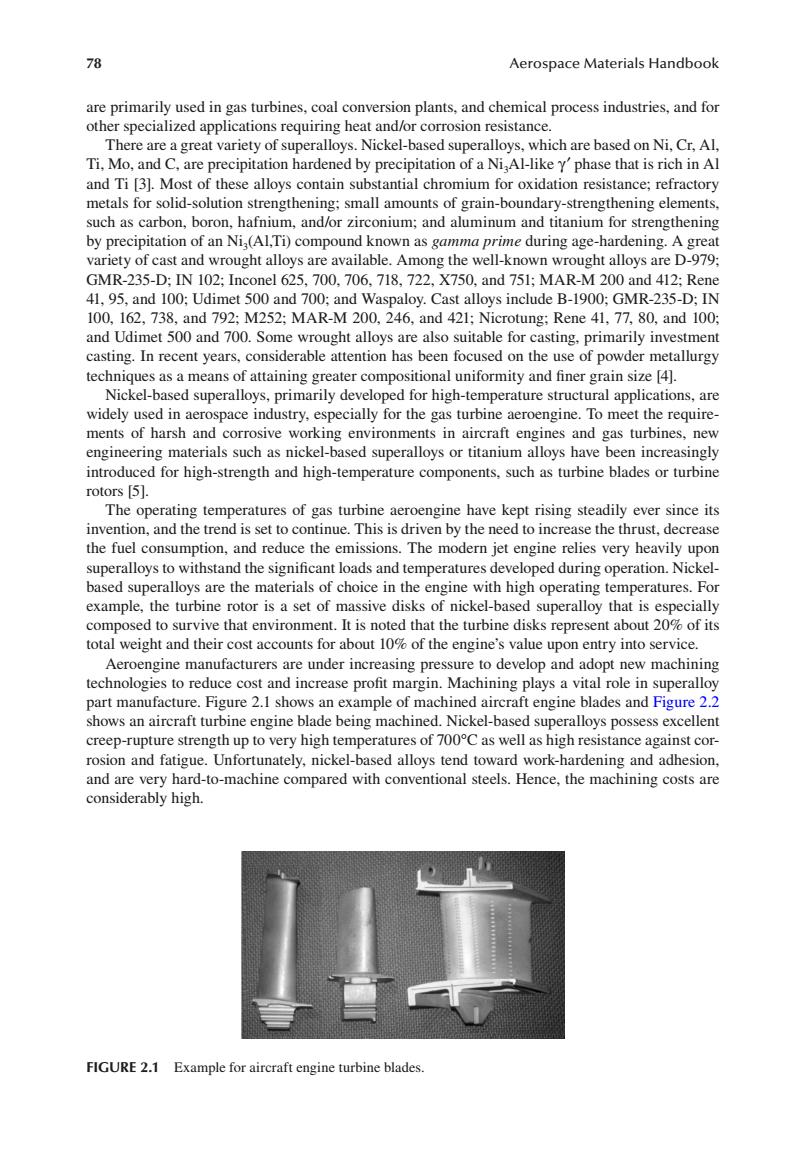正在加载图片...

78 Aerospace Materials Handbook are primarily used in gas turbines,coal conversion plants,and chemical process industries,and for other specialized applications requiring heat and/or corrosion resistance. There are a great variety of superalloys.Nickel-based superalloys,which are based on Ni,Cr,Al, Ti,Mo,and C.are precipitation hardened by precipitation of a Ni Al-like y'phase that is rich in Al and Ti [3].Most of these alloys contain substantial chromium for oxidation resistance;refractory metals for solid-solution strengthening;small amounts of grain-boundary-strengthening elements, such as carbon,boron,hafnium,and/or zirconium;and aluminum and titanium for strengthening by precipitation of an Ni(Al,Ti)compound known as gamma prime during age-hardening.A great variety of cast and wrought alloys are available.Among the well-known wrought alloys are D-979; GMR-235-D:N102:Inconel625,700,706,718,722,X750,and751;MAR-M200and412:Rene 41,95,and 100;Udimet 500 and 700;and Waspaloy.Cast alloys include B-1900;GMR-235-D;IN 100,162,738,and792:M252:MAR-M200,246,and42l;Nicrotung:Rene41,77,80,and100: and Udimet 500 and 700.Some wrought alloys are also suitable for casting,primarily investment casting.In recent years,considerable attention has been focused on the use of powder metallurgy techniques as a means of attaining greater compositional uniformity and finer grain size [4]. Nickel-based superalloys,primarily developed for high-temperature structural applications,are widely used in aerospace industry,especially for the gas turbine aeroengine.To meet the require- ments of harsh and corrosive working environments in aircraft engines and gas turbines,new engineering materials such as nickel-based superalloys or titanium alloys have been increasingly introduced for high-strength and high-temperature components,such as turbine blades or turbine rotors [5]. The operating temperatures of gas turbine aeroengine have kept rising steadily ever since its invention,and the trend is set to continue.This is driven by the need to increase the thrust,decrease the fuel consumption,and reduce the emissions.The modern jet engine relies very heavily upon superalloys to withstand the significant loads and temperatures developed during operation.Nickel- based superalloys are the materials of choice in the engine with high operating temperatures.For example,the turbine rotor is a set of massive disks of nickel-based superalloy that is especially composed to survive that environment.It is noted that the turbine disks represent about 20%of its total weight and their cost accounts for about 10%of the engine's value upon entry into service. Aeroengine manufacturers are under increasing pressure to develop and adopt new machining technologies to reduce cost and increase profit margin.Machining plays a vital role in superalloy part manufacture.Figure 2.1 shows an example of machined aircraft engine blades and Figure 2.2 shows an aircraft turbine engine blade being machined.Nickel-based superalloys possess excellent creep-rupture strength up to very high temperatures of 700C as well as high resistance against cor- rosion and fatigue.Unfortunately,nickel-based alloys tend toward work-hardening and adhesion, and are very hard-to-machine compared with conventional steels.Hence,the machining costs are considerably high. FIGURE 2.1 Example for aircraft engine turbine blades.78 Aerospace Materials Handbook are primarily used in gas turbines, coal conversion plants, and chemical process industries, and for other specialized applications requiring heat and/or corrosion resistance. There are a great variety of superalloys. Nickel-based superalloys, which are based on Ni, Cr, Al, Ti, Mo, and C, are precipitation hardened by precipitation of a Ni3Al-like γ ′ phase that is rich in Al and Ti [3]. Most of these alloys contain substantial chromium for oxidation resistance; refractory metals for solid-solution strengthening; small amounts of grain-boundary-strengthening elements, such as carbon, boron, hafnium, and/or zirconium; and aluminum and titanium for strengthening by precipitation of an Ni3(Al,Ti) compound known as gamma prime during age-hardening. A great variety of cast and wrought alloys are available. Among the well-known wrought alloys are D-979; GMR-235-D; IN 102; Inconel 625, 700, 706, 718, 722, X750, and 751; MAR-M 200 and 412; Rene 41, 95, and 100; Udimet 500 and 700; and Waspaloy. Cast alloys include B-1900; GMR-235-D; IN 100, 162, 738, and 792; M252; MAR-M 200, 246, and 421; Nicrotung; Rene 41, 77, 80, and 100; and Udimet 500 and 700. Some wrought alloys are also suitable for casting, primarily investment casting. In recent years, considerable attention has been focused on the use of powder metallurgy techniques as a means of attaining greater compositional uniformity and finer grain size [4]. Nickel-based superalloys, primarily developed for high-temperature structural applications, are widely used in aerospace industry, especially for the gas turbine aeroengine. To meet the requirements of harsh and corrosive working environments in aircraft engines and gas turbines, new engineering materials such as nickel-based superalloys or titanium alloys have been increasingly introduced for high-strength and high-temperature components, such as turbine blades or turbine rotors [5]. The operating temperatures of gas turbine aeroengine have kept rising steadily ever since its invention, and the trend is set to continue. This is driven by the need to increase the thrust, decrease the fuel consumption, and reduce the emissions. The modern jet engine relies very heavily upon superalloys to withstand the significant loads and temperatures developed during operation. Nickelbased superalloys are the materials of choice in the engine with high operating temperatures. For example, the turbine rotor is a set of massive disks of nickel-based superalloy that is especially composed to survive that environment. It is noted that the turbine disks represent about 20% of its total weight and their cost accounts for about 10% of the engine’s value upon entry into service. Aeroengine manufacturers are under increasing pressure to develop and adopt new machining technologies to reduce cost and increase profit margin. Machining plays a vital role in superalloy part manufacture. Figure 2.1 shows an example of machined aircraft engine blades and Figure 2.2 shows an aircraft turbine engine blade being machined. Nickel-based superalloys possess excellent creep-rupture strength up to very high temperatures of 700°C as well as high resistance against corrosion and fatigue. Unfortunately, nickel-based alloys tend toward work-hardening and adhesion, and are very hard-to-machine compared with conventional steels. Hence, the machining costs are considerably high. FIGURE 2.1 Example for aircraft engine turbine blades